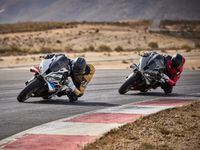When a motorcycle hits a bump while leaned over in a corner, the disturbance caused by the bump resolves into two components – one vertical, one horizontal. The stiffer the motorcycle’s suspension springs and damping are, the firmer the push the motorcycle will receive from the bump.
Because each action must have an equal and opposite reaction, it is the grip of the tires on the pavement that must deliver the bump’s push to the bike, and the reaction from that push also pushes both down and sideways (toward the outside of the corner) on the tire.
When the pavement is wet, tire grip is somewhat reduced. It is amazing to see the large lean angles that are possible on rain tires (those with drainage grooves in their tread surfaces) made for racing, but there are limits. To a typical dry lap-time of 2 minutes, a wet track (as opposed to a downpour with water running across the pavement) adds about ten seconds, which works out to a slowing of only about 8 percent. This slowing appears as both reduced corner speeds and the resulting slower average straightaway speeds caused by lower corner exit speeds. The underlying cause is rain’s reduction of the maximum tire grip available. This makes it easier for the sideways component of the push delivered by a bump in a corner to kick the tire loose. To prevent this happening, the rider adopts slightly lower corner speeds.
To maximize what grip there is, race teams also change to a “wet set-up” in rain, mainly consisting of lower-rate springs and reduced damping force. This, by softening the bump’s push on the bike, asks less of the tire grip which must deliver that push.
Why not use these softer spring and damping rates all the time? In the dry, the greater tire grip available would compress the suspension more in corners, bringing the risk of bottoming the suspension (the shock of which greatly upsets tires) or of “jacking” – lifting the bike off its tires when some part of the machine grounds hard on the pavement.
Sometimes a rider decides to run slick tires even on a moist track because he/she knows that wet tires can quickly overheat and lose grip in semi-dry or drying conditions. This makes it tempting to keep the suspension on a stiffer dry setting, but even in these in-between conditions there are wetter and not-so-wet places on the track. You only have to fall once to be out of contention! So in these in-between conditions, if you have chosen slicks, it’s best to give them all the help you can – with a soft wet set-up that makes the most of what grip there is.
In the dry, riders who use a stop-and-go style – braking late and hard, then getting turned abruptly to use the rest of the turn to accelerate to a high exit speed – need the quicker response of stiffer suspension, and their hard braking requires fork springs stiff enough not to bottom even when carrying 100% of the weight of machine, full fuel, and rider. Such riders are less concerned about ultimate grip because their shorter zone of turning is less dependent upon peak tire grip.
The corner-speed rider, because apex speed is higher, resembles a rain rider in needing all the side-grip possible – all the way around the turn. Because apex speed is higher, this rider has less need of suspension-bottoming braking and so can afford somewhat softer springing that makes the most of corner grip. To keep the tires gripping at their maximum, this rider must make all transitions smoothly, with no sudden gymnastics on the bike. Just like a rain rider.











/cloudfront-us-east-1.images.arcpublishing.com/octane/ARQP5T4CR5EEFGSVF46RR3QB4U.jpg)
/cloudfront-us-east-1.images.arcpublishing.com/octane/X5TB7BDV4BA2RPSY54ZGK27RP4.jpg)
/cloudfront-us-east-1.images.arcpublishing.com/octane/REUHOJXRDBGZ5IHBYZCCBCISPA.jpg)
/cloudfront-us-east-1.images.arcpublishing.com/octane/52LGJTCKBFEHDF7S7H4CVUIMGM.jpg)
/cloudfront-us-east-1.images.arcpublishing.com/octane/YMWAIPIPSJAOXOU3QMJMGH37OM.jpg)


/cloudfront-us-east-1.images.arcpublishing.com/octane/EJ6KZRGAYBCVXNL2PJXL37UVWQ.jpg)
/cloudfront-us-east-1.images.arcpublishing.com/octane/AAN4TI76M5H5JMUVEIGASWXBDU.jpg)
/cloudfront-us-east-1.images.arcpublishing.com/octane/P3RXD2UCPFF37CMB7CHPVKXORY.jpg)
/cloudfront-us-east-1.images.arcpublishing.com/octane/VZEG2EJI2RDFZNHLRZMU56MD3Q.jpg)
/cloudfront-us-east-1.images.arcpublishing.com/octane/GVJQO5FFOFBWNGODOBRB4FBAW4.jpg)
/cloudfront-us-east-1.images.arcpublishing.com/octane/BIVAK2SFIBDJJM25E7I5VU2FJE.jpg)
/cloudfront-us-east-1.images.arcpublishing.com/octane/CH5VX52UG5CFHOVH5A6UYEFWWA.jpg)
/cloudfront-us-east-1.images.arcpublishing.com/octane/ZVGJNGZRU5C33N7KN23BBFKSC4.jpg)


/cloudfront-us-east-1.images.arcpublishing.com/octane/CZ5OM3E43ZEXJHY7LCYXCHLIKI.jpg)
/cloudfront-us-east-1.images.arcpublishing.com/octane/DF5T4K5KPZFJXFCTGPYR77PKJM.jpg)
/cloudfront-us-east-1.images.arcpublishing.com/octane/RMCT2KVQBJHBZMRTSLOVPMOILU.jpg)

/cloudfront-us-east-1.images.arcpublishing.com/octane/K45KB2XHQVA65DX7VN4ZSMT2BI.jpg)
/cloudfront-us-east-1.images.arcpublishing.com/octane/FNHXQQ56BRD7TO4YIJ453PNG2M.jpg)
/cloudfront-us-east-1.images.arcpublishing.com/octane/OIKJC4JA3ZH7BMKUGWYKBIY5FA.jpg)
/cloudfront-us-east-1.images.arcpublishing.com/octane/MT2SAEWY6FDXFBYSLDE3AEFDTM.jpg)